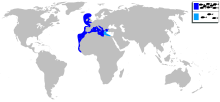- Cepola macrophthalma
-
Cepola macrophthalma 
Scientific classification Kingdom: Animalia Phylum: Chordata Class: Actinopterygii Order: Perciformes Family: Cepolidae Genus: Cepola Species: C. macrophthalma Binomial name Cepola macrophthalma
(Linnaeus, 1758)
Distribution of Cepola macrophthalma
- dark blue: common
- light blue: uncommon
Synonyms Ophidion macrophthalmum Linnaeus 1758
Cepola rubescens Linnaeus 1764
Cepola taenia Linnaeus 1766
Cepola serpentiformis Lacépède 1800
Cepola marginata Rafinesque 1810
Cepola longicauda Swainson 1839
Cepola truncata Swainson 1839
Cepola jugularis Swainson 1839
Cepola gigas Swainson 1839
Cepola attentuata Swainson 1839
Cepola novemradiata Swainson 1839Cepola macrophthalma is a bandfish of the family Cepolidae. It is found in the eastern Atlantic and Mediterranean from Senegal north to Norway.[1] This species is known as the red bandfish, though this name is also given to other members of the genus Cepola.[2]
Contents
Distribution
It is found on the coast and inner continental shelf of the eastern Atlantic between northern Senegal and Norway and the Mediterranean west of the Aegean Sea and the Nile Delta.[1] It can be found on sandy and muddy ocean bottoms at depths of between 10 and 400 m (33-1,310 ft).[1][3]
Description
It has a thin, ribbon-like body, which tapers to a pointed tail. It is red in color, with an orange or yellow underside. It has large, silvery eyes. Its dorsal and anal fins stretch the length of its body and are nearly continuous with its tail (caudal fin). It has a large mouth, at an oblique angle, with thin, glassy, widely-spaced teeth.[1]
These fish are highly variable in length, but an average length is 40.0 cm total length (15.7 in). The maximum length recorded for this species is 80.0 cm total length (31.5 in).[1] Taxonomic distinguishing features include 67–70 dorsal fin soft rays, 60 anal fin soft rays, two unsegmented dorsal fin rays, and a caudal fin with long median rays free at the tips.[1]
Ecology and behavior
Little was known of this species's behavior until a population was discovered off the coast of the island of Lundy off the coast of Devon. Since then, many studies have been conducted on the population there, and on captive fish from Lundy.[3] The population at Lundy once comprised around 14,000 individuals, but numbers have dropped severely, despite a ban on fishing in Lundy's waters.[4][5]
These fish are burrowers, and they feed largely like garden eels, sticking their bodies out of their burrows to catch zooplankton. Unlike garden eels, they are not fixed in their burrows, but can move about both inside their burrows and in the open.[3] Their burrows have funnel-shaped openings, due to the large quantities of sediments they displace to construct their burrows, and they consist largely of single elliptical vertical shafts with a chamber at the bottom. The burrows reach depths of up to 1 m (3 ft), and 49 cm (19 in) is considered to be typical.[3] Bandfish excavate and maintain their burrows at dawn or dusk, with their mouth, and by pushing mud about with their body. They displace about three litres (three quarters of a gallon) of mud and sand in the excavation of a single burrow, and they take around six hours to construct their burrows.[3] Their burrows often connect with those of the crab Goneplax rhomboides and other burrowing fish and crustaceans, and these associations may be deliberate.[6]
Bandfish are an important part of the diets of many oceanic predators, especially john dories,[7] but also other fish, common dolphins[8] and the musky octopus, Eledone moschata.[9] Bandfish may have taken up a burrowing and zooplanktonophagic ecological niche due to strong pressures from predators.[10]
As food
Historically, this species was an important food fish. The earliest recorded recipe, by the Greek cook Mithaecus, was for this species.[11] Andrew Dalby translated it as follows:
Tainia: gut, discard the head, rinse, slice; add cheese and oil.[12]
Tainia was the name by which the ancient Greeks called Cepola macrophthalma, and the oil was, of course, olive oil.[12] In modern times the species is of a lesser importance. In some countries (such as Italy and Spain) it is still consumed, but in others (such as Greece) it is generally discarded when caught by fishermen trying to catch more desirable species.[13] This fish is prized by British deep-sea anglers, and poaching by anglers is a major threat to the population at Lundy.[4]
References
- ^ a b c d e f Froese, Rainer, and Daniel Pauly, eds. (2009). "Cepola macrophthalma" in FishBase. November 2009 version.
- ^ Froese, Rainer, and Daniel Pauly, eds. (2009). Species of Cepola in FishBase. November 2009 version.
- ^ a b c d e Atkinson, R. J. A.; Pullin, R. S. (1996). "Observations on the Burrows and Burrowing Behaviour of the Red Band-Fish, Cepola rubescens L.". Marine Ecology 17 (1–3): 23–40. doi:10.1111/j.1439-0485.1996.tb00487.x.
- ^ a b Pope, Frank (6 December 2008). "Lundy's S.O.S: a blueprint for sustainable fishing?". The Times. http://www.timesonline.co.uk/tol/news/environment/article5251791.ece. Retrieved 21 November 2009.
- ^ "Getting a close-up look of Lundy's sealife". Where I Live. BBC Devon. 9 October 2003. http://www.bbc.co.uk/devon/outdoors/nature/2003/lundy_undersea.shtml. Retrieved 22 November 2009.
- ^ United Kingdom Marine Special Areas of Conservation. "Interactions between megafaunal burrowers". Community ecology: interactions between species. http://www.ukmarinesac.org.uk/communities/seapens/sp3_2.htm. Retrieved 22 November 2009.
- ^ Stergiou, K. I.; Fourtouni, H. (1991). "Food habits, ontogenetic diet shift and selectivity in Zeus faber Linnaeus, 1758". Journal of Fish Biology 39 (4): 589–603. doi:10.1111/j.1095-8649.1991.tb04389.x. http://ichthyology.bio.auth.gr/files/stergiou/B/B11.pdf. Retrieved 3 November 2009.
- ^ Silva, M. A. (1999). "Diet of common dolphins, Delphinus delphis, off the Portuguese continental coast". Journal of the Marine Biological Association of the United Kingdom 79 (3): 531–530. doi:10.1017/S0025315498000654. http://www.horta.uac.pt/projectos/cetamarh/Artigos/artigo4.pdf. Retrieved 3 November 2009.
- ^ Şen, Halil (2007). "Food Preference of Eledone moschata Lamarck, 1799 (Cephalopoda: Octopodidae) in Captive Conditions". International Journal of Natural and Engineering Sciences 1 (2): 29–31. http://www.nobelonline.net/UserFiles/File/4hsen.pdf. Retrieved 22 November 2009.[dead link]
- ^ Stergiou, K. I.; Kokan, Bože; Vrgoč, Nedo; Glamuzina, Branko; Conides, Alexis J.; Skaramuca, Boško (1993). "Abundance-depth relationship, condition factor, and adaptive value of zooplanktonophagy for red bandfish, Cepola macrophthalma". Journal of Fish Biology 42 (3): 645–660. doi:10.1111/j.1439-0426.2007.01047.x.
- ^ Dalby, Andrew (1996). Siren Feasts. Abingdon, Oxon, England: Routledge. pp. 109–110. ISBN 0-41515657-2.
- ^ a b Dalby, Andrew (2003). Food in the ancient world from A to Z. Abingdon, Oxfordshire, England: Routledge. pp. 79, 220. ISBN 0-41523259-7.
- ^ Stergiou, K. I.; Economidis, P.; and Sinis, A. (1992). "Age, growth, and mortality of red bandfish, Cepola macrophthalma (L.), in the western Aegean Sea (Greece)". Journal of Fish Biology 40 (3): 395–418. doi:10.1111/j.1095-8649.1992.tb02586.x.
External links
Categories:- Cepolidae
Wikimedia Foundation. 2010.
